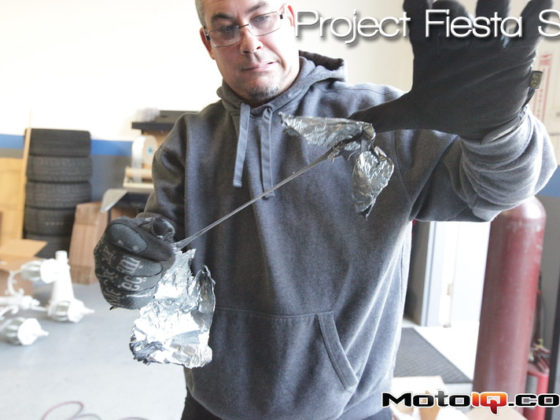MAGAZINE QUOTES AND NUMBERS
Here are a few quotes and magazine performance figures of the Viper relative to other sports cars of the same era:
“Surprising as it sounds, this car is easier to drive at racing speeds on the track than it is to hustle though the countryside… The Viper turned the quickest laps around the handling course at the Chrysler proving grounds and was the easiest to drive. The Viper’s margin over the 911 (Turbo S) was more than 2.5 seconds.” – Car and Driver 7/1997
“I was impressed with the docility of the Viper, how easy it was to drive. In no way is this some finicky high-strung Italian steed; it’s an American horse, and it gets the job done in straightforward style” – Road & Track 8/1997
“Among the best balanced cars on the racetrack. It’s kind of amazing that a private citizen can buy a street car with this much horsepower. If you woke up in the morning in a bad mood, you’d just take this one out for a drive. It’d straighten out everything” – Steve Millen, Road & Track 7/1998
| CAR | LAP TIME | CORNERING G | SLALOM (700ft) | BRAKING (60-0) | 0-60 | QUARTER MILE |
| Viper | 70.55 | 0.98g | 63.6 mph | 155 ft | 4.3 | 12.5 @ 117.2 mph |
| F355 | 73.70 | 0.98g | 62.6 mph | 123 ft | 4.8 | 13.3 @ 110.3 mph |
| 911 | 74.47 | 0.91g | 62.7 mph | 134 ft | 5.0 | 13.5 @ 105.8 mph |
| NSX | 74.53 | 0.92g | 62.1 mph | 134 ft | 4.9 | 13.3 @ 108.1 mph |
| Corvette | 75.19 | 0.92g | 61.5 mph | 123 ft | 5.2 | 13.6 @ 105.7 mph |
| M Roadster | 75.31 | 0.88g | 62.8 mph | 121 ft | 5.2 | 13.9 @ 100.6 mph |
“The Viper GTS-R is a monster. But it’s a monster you can have fun with. What it’s lacking in finesse, it makes up in power. Its character is much like that of the Cobra, which is crude, but that’s the nature of this beast. In these cars, you use power to pull yourself out. The learning curve is steep – mainly you need to get organized in the cockpit before you can start ripping into it. It requires the most driving of the bunch (F355, NSX, Esprit V8, Corvette, Carrera 4). The car does feel sloppy, but you learn to deal with theat sloppiness. And although you’re very busy in the cockpit, the rewards are nice”. –Mario Andretti, Road & Track 6/1999
| CAR | SEGMENT TIMES |
| Viper GTS-R | 21.74 |
| NSX Zanardi Edition | 22.46 |
| F355 Spider | 22.80 |
| 911 Carrera 4 | 22.83 |
| Corvette Hardtop | 23.15 |
| Lotus Esprit V8 | 23.66 |
“If the Viper GTS hadn’t been dead last in braking performance, it would’ve thoroughly spanked its opposition at the road course… sticky tires gave the Dodge race-car-level grip but the ABS-less Viper had devilish tendency to lock its fronts under heavy braking, raising the Dodge’s lap time by a few tenths.” – MotorTrend 5/1997
| CAR | LAP TIME | CORNERING G | SLALOM (600ft) | BRAKING (60-0) | 0-60 | 1/4 MILE | ONE-MILE | TOP SPEED |
| Viper GTS | 39.4 | 1.01g | 73.6 mph | 129 ft | 4.0 | 12.2 @ 119.3 mph | 30.6 @ 169.4 mph | 187.3 mph |
| F355 | 39.5 | 1.01g | 72.1 mph | 114 ft | 4.8 | 13.2 @ 112.2 mph | 33.2 @ 155.2 mph | 180.0 mph |
| 911 Turbo | 40.2 | 1.00g | 69.6 mph | 111 ft | 3.7 | 12.3 @ 114.1 mph | 31.2 @ 162.6 mph | 181.8 mph |
| Supra Turbo | 41.3 | 0.94g | 68.9 mph | 115 ft | 5.1 | 13.6 @ 106.0 mph | 34.7 @ 149.7 mph | 158.1 mph |
| NSX-T | 41.5 | 0.94g | 69.5 mph | 120 ft | 4.8 | 13.3 @ 106.7 mph | 34.0 @ 150.2 mph | 162.2 mph |
| Corvette | 41.7 | 0.93g | 66.2 mph | 116 ft | 4.8 | 13.2 @ 109.3 mph | 33.4 @ 152.4 mph | 196.3 mph |
| 3000GT VR4 | 42.3 | 0.95g | 67.5 mph | 116 ft | 4.8 | 13.6 @ 100.5 mph | 35.6 @ 142.0 mph | 155.7 mph |
MotorTrend 5/1998:
| CAR | LAP TIME | CORNERING G | SLALOM (600ft) | BRAKING (60-0) | 0-60 | 1/4 MILE | ONE-MILE | TOP SPEED |
| F355 | 38.8 | 0.97g | 70.8 mph | 111 ft | 4.6 | 13.0 @ 109.7 mph | 32.6 @ 154.1 mph | 177.6 mph |
| Viper GTS | 38.9* | 1.01g | 72.5 mph | 122 ft | 4.1 | 12.2 @ 118.6 mph | 30.1 @ 173.3 mph | 192.6 mph |
| 911 | 39.3 | 0.92g | 68.7 mph | 111 ft | 4.9 | 13.4 @ 105.2 mph | 33.0 @ 150.3 mph | 174.8 mph |
| Esprit V8 Turbo | 40.0 | 0.98g | 70.0 mph | 118 ft | 4.4 | 12.8 @ 111.8 mph | 32.1 @ 158.4 mph | 179.4 mph |
| Corvette | 40.0 | 0.93g | 66.2 mph | 116 ft | 4.8 | 13.2 @ 109.3 mph | 32.9 @ 150.4 mph | 173.9 mph |
| Panoz Roadster | 40.4 | 0.94g | 66.9 mph | 110 ft | 4.6 | 13.3 @ 101.5 mph | 35.1@129.9 mph | 134.0 mph |
| M Roadster | 40.5 | 0.91g | 68.7 mph | 115 ft | 5.1 | 13.7 @ 101.4 mph | 35.3 @ 136.3mph | 139.7 mph |
| DB7 | 41.1 | 0.87g | 66.7 mph | 125 ft | 5.7 | 14.3 @ 98.1 mph | 35.2 @ 142.4 mph | 163.5 mph |
*The Viper had non-spec All-Season Michelin Pilot XGT Z4 M+S front tires for the road course test.
“I attempt a lap of power oversteer around the (skid)pad: controlling a fully lose GTS in this manner is like balancing a grape on a knife” – MotorTrend 7/1999
| CAR | CORNERING G | SLALOM (600ft) | BRAKING (60-0) | 0-60 | 1/4 MILE | ONE-MILE |
| Viper GTS | 0.98g | 70.1 mph | 126 ft | 4.1 | 12.2 @ 119.8 mph | 30.9 @ 168.4 mph |
| 550 Maranello | 0.93g | 68.1 mph | 114 ft | 4.2 | 12.5 @ 116.9 mph | 31.2 @ 168.0 mph |
| NSX Zanardi | 0.99g | 70.5 mph | 116 ft | 4.8 | 13.1 @ 109.1 mph | 34.1 @ 150.6 mph |
| Corvette | 0.90g | 68.1 mph | 116 ft | 4.8 | 13.3 @ 108.6 mph | 33.7 @ 155.8 mph |
| E55 | 0.85g | 65.9 mph | 114 ft | 4.8 | 13.3 @ 107.1 mph | 34.2 @ 150.5 mph |
| Carrera 4 | 0.98g | 68.4 mph | 115 ft | 5.0 | 13.4 @ 104.3 mph | 34.5 @ 148.6 mph |
| M Coupe | 0.87g | 67.4mph | 119 ft | 5.4 | 13.8 @ 101.4 mph | 36.0 @ 137.5 mph |
IN THE COCKPIT
The seating position is not ideal and is somewhat compromised due to packaging the entire engine behind the front wheel centerline. This causes the transmission to encroach on the cabin and places the throttle basically in the center of the steering wheel and the brake and clutch offset to the left. This really isn’t any worse than the front wheel encroaching on the cabin and shifting your feet to the right in say an older Lotus, Lamborghini, or Ferrari like a 512TR or F355. While some may find this very distracting, I personally did not notice it or was bothered by it or a lack of a dead pedal while on track since there is enough room in the foot well to operate all the pedals.
I was pleasantly surprised with the amount of headroom in the Viper. I have a really long torso which makes it very difficult to fit in most cars with a helmet on. The Viper actually had a lot more head room than an Acura NSX and even a BMW M3! While I did not have any vertical issue with head room, the “Double-Bubble” roof does slope down to the side which restricted the ability to tilt my head much to the left. The seats had decent bolstering and lateral support and thanks to the adjustable pedals, I was able to get a fantastic driving position which I typically don’t find in sports cars that are older than 5-10 years.
The steering was a little on the heavier side but communicated what the front tires were doing very well. Vipers are hard on their power steering fluid and sensitive to the type and condition of the fluid, so we will report back after a flush. The shifter is still a bit vague and the throw is not very short, but it does not feel like you’re rowing a boat and it does not require a lot of force or effort. The clutch is not heavy and after a few laps, finding 3rd gear becomes easy with just the slightest pressure to the right on the stick when doing the 2-3 gear shift. All other gears are pretty easy to find in the Borg Warner/Tremec T56.
This video demonstrates the neutrality of the Viper’s chassis which can be driven to enter or exit a corner with either understeer or oversteer depending on the driver’s inputs:
VIDEO
CONCLUSION
We can sum up the Viper by essentially calling it a big Miata or S2000 with a bunch of torque. Needless to say it is a lot of fun to drive on a track. The cornering power of the car (which rivals the McLaren 12C that we reviewed) is greater than the refinement of the dampers and driving dynamics, but that’s not to say the Viper bad in stock form, but rather it requires the driver’s attention to give precise and accurate inputs compared to say a Nissan GTR which does everything for you. Going back to the original question, if a “Driver’s Car” needs to have an element of a challenge in addition to turning fast lap times and having a neutral chassis, if so, then the Viper surely fits this title.
There are some more maintenance items like drivetrain fluids that need to be gone through, but overall we really enjoyed the car even more after taking it to the track. There are some shortcomings to the Viper. First, the chassis is not very rigid. A modern unibody is far stiffer than the “hand-crafted” welded square stock frame on the Viper. I honestly expected it to drive with the mushy, sloppy, and vague driving experience similar to a flimsy Fox Body Mustang when on track, but was really surprised that the Viper did not have these characteristics. The chassis was consistent and responsive, and felt a lot tighter than it actually is. Secondly, while the suspension was actually really good for its time, there is a lot that can be improved on to make it substantially more capable than it already is, and we will. Lastly, the brakes (bias) is terrible and really limits the braking ability of the car. The last 2 main points are pretty easy to improve on and we will be going over them in future articles, so stay tuned!
SOURCES:




